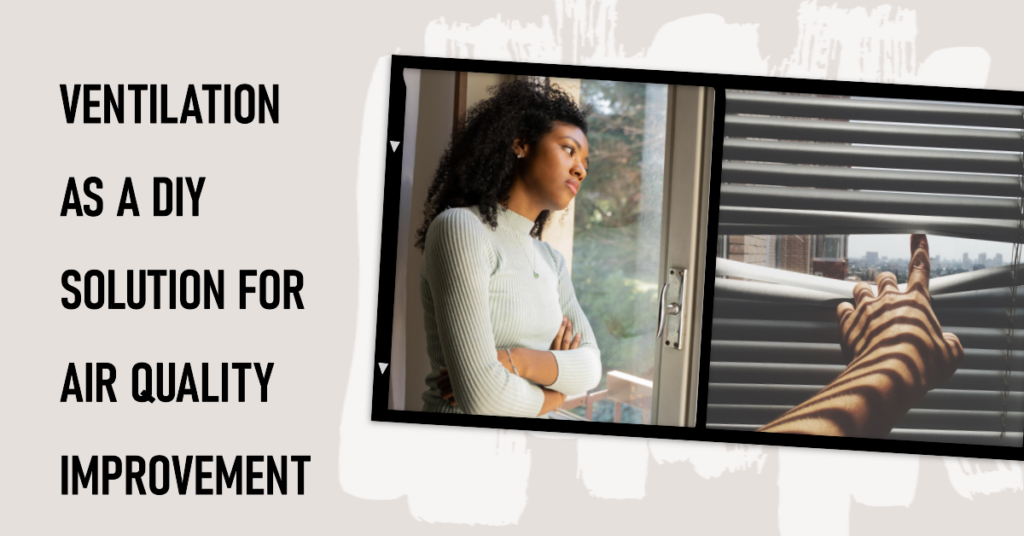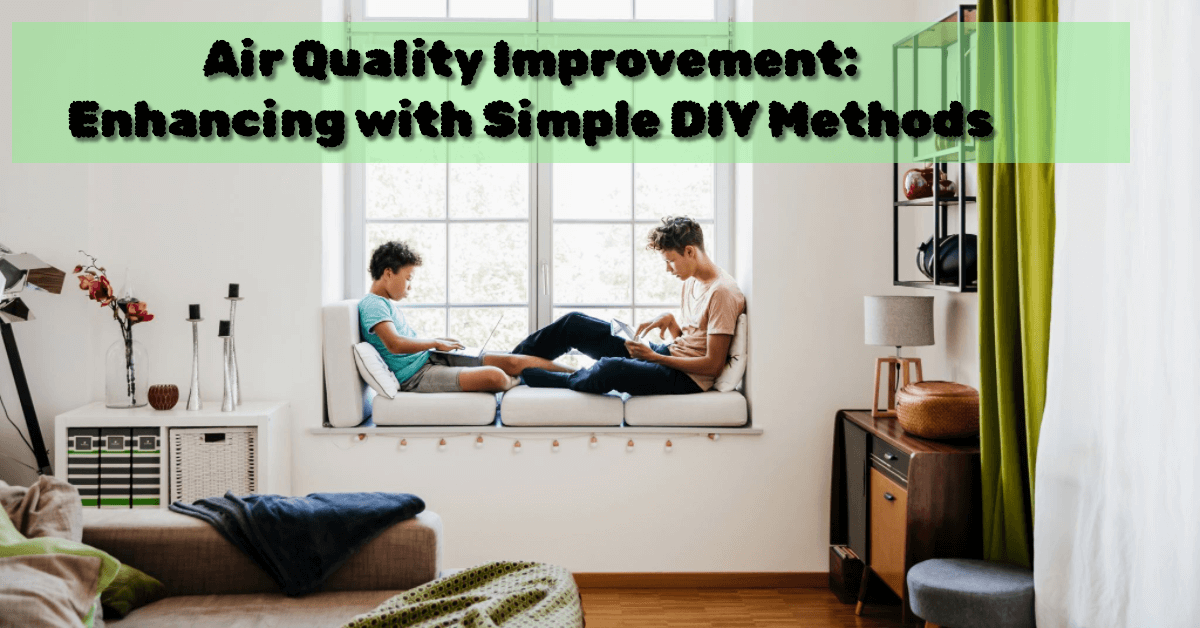“Air Quality Improvement: Enhancing with Simple DIY Methods” is your comprehensive guide to understanding and optimizing the air you breathe indoors. In this article, we’ll embark on a journey to uncover the significance of indoor air quality and explore the pivotal role that do-it-yourself (DIY) methods can play in transforming your living space into a sanctuary of fresh, clean air.
Indoor air quality, a topic often underestimated, wields a profound impact on our health and overall well-being. Whether you’re concerned about allergens, pollutants, or simply yearning for a breath of fresh air at home, this article will equip you with the knowledge and tools needed to make a real difference. From natural ventilation and houseplants to DIY air purification and humidity control, we’ll navigate the realm of simple yet highly effective methods that empower you to create a healthier living environment. So, let’s dive into the world of cleaner, crisper air right within the comfort of your own home.
Before we go into the DIY air quality improvement, let’s take a moment to understand why it’s so crucial. The air we breathe indoors can have a profound impact on our well-being. It’s not just about comfort; it’s about your health and happiness.
So, why should you care about indoor air quality, and how can DIY methods help? In this article, we’ll address these questions, giving you a compelling reason to make a change.
Introduction
Importance of Indoor Air Quality
Indoor air quality (IAQ) often takes a back seat to outdoor air concerns, but it plays a crucial role in our overall well-being. We spend a significant portion of our lives indoors, and the quality of the air we breathe can directly impact our health, comfort, and productivity. Poor IAQ can lead to a range of issues, including allergies, respiratory problems, and even long-term health conditions.
Good indoor air quality, on the other hand, can boost your mood, productivity, and overall quality of life. It’s essential to recognize that we have the power to influence and improve the air in our living spaces. The first step in this journey is understanding what indoor air quality means and why it matters.

The Role of DIY Methods in Air Quality Improvement
DIY methods empower us to take control of our indoor air quality without breaking the bank. Whether you’re concerned about allergens, pollutants, or contaminants, there are cost-effective and creative solutions at your disposal. This article will explore various DIY approaches, from natural ventilation to houseplants and air filtration systems.
By the time you finish reading, you’ll have a toolkit of strategies to create a healthier and more pleasant living environment. So, let’s start our journey towards breathing easy, starting with the fundamentals of indoor air quality.

Understanding Indoor Air Quality
Before we delve into DIY solutions, it’s essential to understand the very air we’re trying to improve. What defines indoor air quality, and what factors affect it? Let’s take a closer look.
What Defines Indoor Air Quality
Indoor air quality is a measure of the air’s cleanliness and its impact on the health and comfort of occupants. It’s determined by the presence of various pollutants, such as particulate matter, volatile organic compounds (VOCs), and biological contaminants. These pollutants can originate from a range of sources, including cooking, cleaning, pets, and outdoor influences.
IAQ is often assessed based on factors like temperature, humidity, ventilation, and the concentration of specific pollutants. It’s a complex interplay of variables, but it can be managed effectively with the right approach.
Factors Affecting Indoor Air Quality
Several factors can impact IAQ, including inadequate ventilation, the choice of building materials, and the presence of allergens and pollutants. Temperature and humidity also play vital roles, as they can create conditions conducive to mold growth and the spread of airborne contaminants.
Understanding these factors is crucial to identifying areas where DIY air improvements can make a real difference. It’s not just about making your home look better; it’s about making it a healthier place to live.
Health Implications of Poor Air Quality
Poor indoor air quality is more than just an inconvenience; it can have severe health implications. Long-term exposure to indoor air pollutants has been linked to allergies, asthma, respiratory infections, and even chronic conditions like cardiovascular disease and cancer.
Children, the elderly, and individuals with preexisting health conditions are particularly vulnerable. The good news is that with the right knowledge and tools, you can take steps to protect yourself and your loved ones from these risks.
| Common Indoor Air Pollutants | Source | Health Effects |
|---|---|---|
| Tobacco Smoke | Cigarette and cigar smoke | Respiratory issues, cancer risk |
| Pollen | Outdoor infiltration, pets | Allergic reactions |
| Dust Mites | Bedding, carpets | Allergies, asthma exacerbation |
Understanding the health risks associated with indoor air pollutants is a crucial motivator for improvement of air quality in home.

Ventilation as a DIY Solution for Air Quality Improvement
Proper ventilation is the backbone of good indoor air quality. It ensures a constant supply of fresh air while expelling pollutants and excess moisture. In this section, we’ll explore the importance of ventilation and various DIY methods to achieve it.
Importance of Proper Ventilation
Effective ventilation helps dilute indoor air pollutants and ensures a continuous flow of fresh outdoor air into your living spaces. It’s particularly vital in areas where indoor activities, such as cooking and cleaning, release pollutants. Additionally, adequate ventilation prevents moisture buildup, which can lead to mold growth.
Without proper ventilation, indoor air can become stagnant and polluted, increasing health risks and discomfort. Now, let’s discuss DIY methods for achieving effective ventilation.
Natural Ventilation Methods
Natural ventilation relies on the movement of air through openings like windows, doors, and vents. This method can be highly effective and energy-efficient, as it harnesses natural forces like wind and temperature differences to keep your air fresh. Here are some DIY tips for enhancing natural ventilation:
- Strategically place windows and doors to encourage cross-ventilation.
- Install adjustable window vents to control airflow.
- Use window fans to promote air circulation.
By incorporating these strategies, you can maximize natural ventilation and enjoy fresher indoor air. But what if natural ventilation isn’t sufficient for your needs? That’s where mechanical ventilation options come into play.
Mechanical Ventilation Options
Mechanical ventilation systems use fans or air exchangers to circulate and replace indoor air. These systems are particularly valuable in spaces with limited access to fresh outdoor air. Let’s explore some of the DIY-friendly mechanical ventilation solutions:
- Install exhaust fans in high-humidity areas like the bathroom and kitchen.
- Consider a heat recovery ventilator (HRV) or an energy recovery ventilator (ERV) for energy-efficient air exchange.
- Regularly clean and maintain ventilation systems to ensure their effectiveness.
With these mechanical ventilation options, you can tailor your indoor air quality management to your specific needs and preferences.
Humidity Control for Air Quality Improvement
Humidity levels can significantly impact indoor air quality. Maintaining the right balance is crucial for comfort and health. In this section, we’ll explore the impact of humidity on air quality and DIY methods to control it.
Impact of Humidity on Air Quality
Humidity plays a vital role in determining indoor air quality. Too much humidity can lead to mold growth and dust mites, while overly dry air can cause respiratory discomfort and dry skin. Maintaining optimal indoor humidity levels ensures a healthier living environment.
| Season | Recommended Indoor Humidity |
|---|---|
| Summer | 40-60% |
| Winter | 30-50% |
DIY Humidification and Dehumidification
Controlling indoor humidity can be achieved through various DIY methods. For humidification, consider using a humidifier to add moisture to the air. In contrast, dehumidifiers can help reduce excess moisture during high humidity periods. Additionally, simple practices like properly sealing windows and doors can help maintain humidity levels.
- Use a humidifier to add moisture to dry indoor air during winter.
- Install a dehumidifier in areas prone to excess moisture, like the basement.
- Seal gaps around windows and doors to prevent humid air from entering your home.
By keeping a watchful eye on indoor humidity and implementing these DIY solutions, you can significantly achieve improvement of air quality in your living environment.
Air Quality Monitoring
Monitoring indoor air quality is a crucial step in identifying issues and tracking air improvements. In this section, we’ll discuss the importance of monitoring indoor air and explore DIY air quality testing methods.
Importance of Monitoring Indoor Air
Regular air quality monitoring provides insights into the effectiveness of your DIY air improvements. It helps you identify specific issues, track trends, and ensure your home’s air quality is consistently at its best. Monitoring also raises awareness of potential problems, allowing you to take corrective actions promptly.
As the saying goes, “what gets measured, gets managed.” So, it’s time to measure and manage your indoor air quality effectively.
- Particulate matter (PM2.5 and PM10)
- Carbon dioxide (CO2)
- Volatile organic compounds (VOCs)
DIY Air Quality Testing
You don’t need a specialized lab to assess your indoor air quality. DIY air quality testing kits are readily available and easy to use. These kits can measure various pollutants and provide valuable data for identifying problem areas in your home. Regular testing can guide your efforts in improvement of air quality.
| Type of Testing Kit | What It Measures |
|---|---|
| Particle Counter | Particulate matter (PM2.5 and PM10) |
| CO2 Meter | Carbon dioxide levels |
| VOC Sensor | Volatile organic compounds (VOCs) |
With DIY air quality testing, you can gain valuable insights into your home’s IAQ and ensure you’re on the right track toward cleaner, healthier air.
Allergen Reduction
Indoor allergens can trigger allergies and exacerbate respiratory issues. In this section, we’ll identify common indoor allergens and discuss DIY methods to reduce their presence in your home.
Identifying Common Allergens
Several common allergens can lurk in your indoor environment, causing discomfort and health issues. These include dust mites, dander of pet, pollen, and mold spores. Identifying these culprits is the first step in reducing their impact on your health.
| Allergen | Source |
|---|---|
| Dust Mites | Bedding, carpets, and upholstery |
| Pet Dander | Animal skin flakes and fur |
| Pollen | Outdoor infiltration and plants |
DIY Air Quality Improvement Methods to Reduce Allergens
To create an allergen-free home, you can take various DIY steps. Regular cleaning, using allergen-proof covers, and maintaining good indoor humidity levels are some of the strategies you can employ. Additionally, proper ventilation and the use of air purifiers can help filter out allergens from the air.
- Wash bedding, curtains, and cushions regularly in hot water.
- Use allergen-proof covers on pillows and mattresses.
- Keep pets out of bedrooms and off upholstered furniture.
With these DIY methods, you can create a more comfortable and allergy-friendly living space for you and your family.
Tobacco Smoke and DIY Solutions for Improvement of Air Quality
Tobacco smoke is a significant indoor air pollutant that poses severe health risks. In this section, we’ll address the dangers of indoor smoking and explore DIY strategies for reducing its impact.
Dangers of Indoor Smoking
Indoor smoking releases a myriad of harmful chemicals into the air, including nicotine, tar, and carbon monoxide. Exposure to secondhand smoke can lead to respiratory problems, heart disease, and even lung cancer. If you or someone in your household smokes, it’s crucial to address this issue for the sake of your health and the quality of your indoor air.
- Respiratory issues, including coughing and wheezing.
- Increased risk of lung cancer and heart disease.
- Negative impact on children’s lung development.
Smoking Cessation Strategies
The most effective way for air quality improvement in homes with smokers is to encourage smoking cessation. Support and resources are available to help individuals quit smoking, including nicotine replacement therapy and counseling programs. Quitting smoking not only benefits the smoker’s health but also protects the air quality for everyone in the household.
- Seek counseling and support from healthcare professionals or support groups.
- Consider nicotine replacement therapy, such as patches or gum.
- Create a smoke-free home to reduce exposure to secondhand smoke.
By taking steps to quit smoking and maintaining a smoke-free home, you can significantly improve air in house and the health of your family.
Radon Gas Mitigation for Air Quality Improvement
Radon gas is a naturally occurring radioactive gas that can seep into homes, posing health risks. In this section, we’ll discuss the importance of understanding radon and explore DIY radon testing and mitigation strategies.
Understanding Radon and Its Risks
Radon is a colorless and odorless gas that results from the breakdown of uranium in the soil. It can enter homes through cracks in the foundation and accumulate to dangerous levels. Prolonged exposure to radon can increase the risk of lung cancer, making it a significant concern for indoor air quality.
- Increased risk of lung cancer, especially in smokers.
- Long-term exposure can have severe health consequences.
- Radon is the second leading cause of lung cancer after smoking.
DIY Radon Testing and Mitigation
Testing for radon is a critical step in ensuring your indoor air quality is free from this radioactive gas. DIY radon test kits are readily available and easy to use. If your test results indicate elevated radon levels, mitigation methods can be implemented to reduce exposure, such as sealing cracks and installing radon mitigation systems.
- Use a radon test kit to measure radon levels in your home.
- Seal any cracks and openings in your home’s foundation to prevent radon entry.
- If levels are high, consider installing a radon mitigation system.
By taking action to test for and mitigate radon, you can protect your family from this invisible threat and enjoy cleaner indoor air.
Mold Prevention and Remediation for Air Quality Improvement
Mold growth is a common issue that can significantly impact indoor air quality and health. In this section, we’ll discuss the impact of mold on air quality and explore DIY mold prevention and safe removal techniques.
Mold’s Impact on Air Quality
Mold is a type of fungus that can grow in damp and humid conditions. It releases spores into the air, which can lead to respiratory issues, allergies, and other health problems when inhaled. Mold growth not only affects the air quality but also damages the surfaces it grows on.
- Respiratory issues, including coughing and wheezing.
- Allergic reactions like sneezing, runny nose, and skin rashes.
- Asthma exacerbation and other respiratory conditions.
DIY Mold Prevention
Preventing mold growth is essential for maintaining good indoor air quality. You can do this by controlling moisture, ensuring proper ventilation, and regularly inspecting your home for potential trouble spots. Addressing leaks and maintaining optimal humidity levels are key to mold prevention.
- Fix any water leaks promptly to prevent moisture buildup.
- Use exhaust fans in high-humidity areas like the bathroom and kitchen.
- Maintain indoor humidity levels between 30-50% to discourage mold growth.
By incorporating these preventive measures, you can reduce the risk of mold growth and its impact on your indoor air quality.
Air Quality Improvement in the Kitchen
The kitchen is a hotspot for potential indoor air pollutants due to cooking-related emissions. In this section, we’ll explore the various pollutants generated during cooking and discuss DIY kitchen ventilation and methods to reduce emissions.
Cooking-Related Air Pollutants
Cooking activities release a range of pollutants into the air, including smoke, particulate matter, and volatile organic compounds. These pollutants can affect indoor air quality and health, particularly if not adequately managed. Common sources of pollutants include frying, grilling, and even boiling water.
| Cooking Activity | Common Pollutants Released |
|---|---|
| Frying | Particulate matter and cooking odors |
| Grilling | Smoke and carbon monoxide (from gas grills) |
| Boiling Water | Humidity and potential VOCs from tap water |
DIY Kitchen Ventilation
Proper kitchen ventilation is crucial for reducing the impact of cooking-related pollutants on indoor air quality. You can achieve this by using exhaust fans, opening windows, and investing in range hoods with efficient filtration systems. Effective ventilation can prevent pollutants from accumulating and ensure a healthier kitchen environment.
- Use exhaust fans during and after cooking to remove pollutants quickly.
- Open windows and create cross-ventilation to improve air circulation.
- Install a range hood with a grease and odor filter for efficient pollutant removal.
By implementing these DIY ventilation strategies, you can enjoy your culinary creations without compromising your indoor air quality.
Home Improvement for Better Air
Your home’s structure and building materials can significantly impact indoor air quality. In this section, we’ll discuss air-sealing, insulation, and the use of eco-friendly building materials to enhance your living environment.
Air-Sealing and Insulation
Proper air-sealing and insulation are essential for maintaining a comfortable and energy-efficient home. They help prevent outdoor pollutants from entering and ensure temperature and humidity control. By sealing gaps and insulating your home, you can enhance both energy efficiency and indoor air quality.
- Seal gaps around windows, doors, and plumbing penetrations to prevent drafts and outdoor air infiltration.
- Upgrade insulation in your attic, walls, and floors to improve energy efficiency and comfort.
- Consider weatherstripping doors and windows for additional insulation and draft reduction.
These simple home improvements can make a substantial difference in the quality of the air you breathe at home, while also reducing energy costs.

DIY Air Filtration Systems
Air filtration systems play a crucial role in improving indoor air quality. In this section, we’ll discuss portable air purifiers, DIY air filtration methods, and how to choose the right air filters for your specific needs.
Portable Air Purifiers
Portable air purifiers are effective tools for removing airborne pollutants from your indoor environment. These devices use various technologies, such as HEPA filters and activated carbon, to capture particles and odors. Consider using portable air purifiers in rooms where you spend the most time to ensure cleaner, fresher air.
- Removes allergens, dust, and pet dander from the air.
- Reduces odors and smoke particles, creating a fresher atmosphere.
- Improves air quality for individuals with allergies or respiratory conditions.
DIY Air Filtration Methods
If you prefer a more hands-on approach, you can create DIY air filtration systems using readily available materials. For example, a simple box fan with a high-MERV filter can be an effective and budget friendly air purifier. DIY solutions can be just as efficient in improving indoor air quality when properly implemented.
- Create a DIY air purifier using a box fan and a high-efficiency filter.
- Build an air-cleaning plant wall with air-purifying plants to filter the air naturally.
- Construct a DIY air filtration unit using a box, a fan, and an activated carbon filter for odor control.
By exploring both commercial air purifiers and DIY filtration methods, you can tailor your approach to suit your specific air quality needs and budget.
Conclusion
Air Quality Improvement doesn’t need to be a complex or expensive endeavor. With the DIY methods we’ve explored throughout this article, you can take significant steps to create a healthier living space for you and your loved ones. By understanding the importance of indoor air quality and the variety of strategies at your disposal, you have the power to make a positive impact on your well-being.
From proper ventilation to the use of air-purifying plants, DIY natural cleaners, and humidity control, you have a comprehensive toolbox of strategies to enhance your indoor air quality. Each method serves a unique purpose, contributing to a healthier, more comfortable living environment.
Indoor air quality is a critical aspect of your overall health and well-being. Neglecting it can lead to health issues, discomfort, and reduced quality of life. By taking action through the DIY methods for Air Quality Improvement outlined in this article, you’re not only creating a healthier home but also investing in your long-term health and happiness.
FAQ on Air Quality Improvement
What is the purpose of improving air quality?
Improving air quality is essential to ensure that the air we breathe is clean and safe. Clean air helps prevent health problems, such as respiratory issues, and creates a healthier environment for everyone.
Do air purifiers improve air quality?
Yes, air purifiers can help improve air quality. They work by removing particles like dust, allergens, and pollutants from the air, making the indoor air cleaner and safer to breathe.
How can Californians improve air quality?
Californians can contribute to better air quality by using public transportation, carpooling, reducing vehicle emissions, and supporting clean energy initiatives. These actions help reduce pollution and smog in the state.
How can we solve air quality problems?
Solving air quality problems involves reducing pollution from various sources. This can be achieved through stricter regulations on emissions, transitioning to cleaner energy sources, and promoting eco-friendly practices in industries and daily life.
What are the health benefits of better air quality?
Better air quality leads to improved health by reducing the risk of respiratory diseases, allergies, and other health issues. It also enhances overall well-being and quality of life for individuals and communities.
What are the symptoms of bad air quality?
The symptoms of bad air quality can vary but often include:Respiratory Issues: Coughing, wheezing, shortness of breath, and chest tightness.
Irritated Eyes, Nose, and Throat: Watery or itchy eyes, runny or stuffy nose, and a scratchy throat.
Headaches: Increased exposure to air pollutants can lead to headaches.
Fatigue: Breathing in poor-quality air can make you feel tired and less energetic.
Worsening of Pre-existing Conditions: People with asthma, allergies, or other respiratory conditions may experience exacerbated symptoms.
What are the dangers of poor air quality?
Poor air quality can have serious health and environmental consequences, including:
Respiratory Problems: Prolonged exposure to polluted air can lead to chronic respiratory diseases and worsen existing conditions.
Cardiovascular Issues: Air pollution is linked to heart problems, including heart attacks and strokes.
Reduced Lung Function: Children exposed to poor air quality may experience impaired lung development.
Increased Mortality: Long-term exposure to air pollution is associated with premature death.
Environmental Impact: Poor air quality harms the environment, contributing to climate change and damaging ecosystems.
DheerajSonwane is a dedicated writer with expertise in air purification technologies. He focuses on providing well-researched content to help readers improve indoor air quality in homes and businesses. As the lead writer at AirPurifierMaster.com, Dheeraj offers practical advice his insightful reviews guide individuals in choosing the best air purifiers for their needs.


2 thoughts on “Air Quality Improvement: Enhancing with Simple DIY Methods”